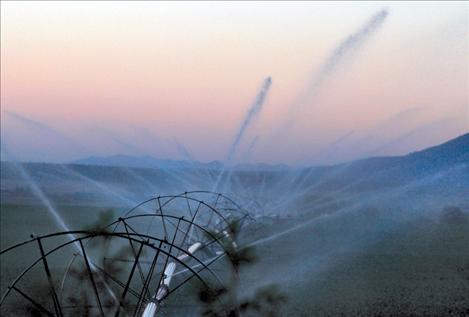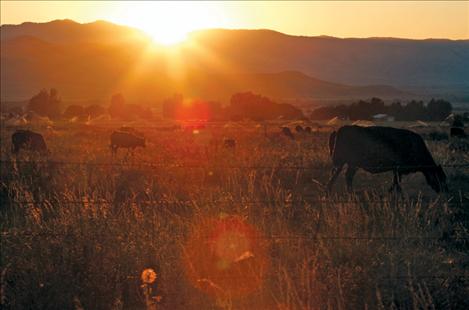Water rights irrigation talks continue
Hey savvy news reader! Thanks for choosing local.
You are now reading
1 of 3 free articles.
RONAN — More than 150 people attended the Flathead Joint Board of Control’s public meeting on Aug. 20 regarding proposed farm turnout allowances outlined for the Flathead Indian Irrigation Project in the current water rights negotiations between the federal government, the state of Montana and the CSKT.
Farm turnout allowances are defined in appendix A in the draft agreement as, “that amount of water as identified in appendix A that the project operator must deliver to the farm turnout on a yearly basis.” Allowances vary between wet, dry and normal years and by basin in the valley.
According to Alan Mikkelsen, adviser to the Cooperative Management Entity which governs the Flathead Indian Irrigation Project, the meeting’s goal was to inform the public on the process that created these allowances, explain the origin of the raw data on water flows and usage, and to address public comments and concerns regarding the proposed farm allowances.
The meeting opened with a detailed presentation by Wade Irions from DOWL HKM, an engineering firm in Billings.
Irions explained the water accounting system used to simulate farm needs in wet, dry and normal years is called the Hydrological River Operations Study System, or HYDROSS. According to the presentation, HYDROSS accounts for every measureable stream, monthly diversion for every project and private ditch, ditch losses, crop consumption, reservoir storage, stream seepage, and losses and gains. Raw data put in the system came from a study performed between 1983 and 2002, a total of 240 months.
Seth Makepeace, hydrologist for the Confederated Salish and Kootenai Tribes, said while the data is 10-years-old, engineers were able to demonstrate HYDROSS’ efficiency by captured hydrologic extremes with a comparison to the Swan River in Bigfork. The engineers chose Swan River because it is a natural flow system rather than a regulated system.
In addition, engineers compensated for today’s irrigation techniques by bringing the irrigated land mapping base model and Flathead pumping plant operations up to 2009’s conditions during simulation.
“Yes, the data is accurate. Yes, it is representative. If it’s properly corrected and accurate data, its value increases with time,” Makepeace said.
Irions said the raw data on the project is some of the best he’s ever worked with.
“We want to provide a factual and scientific basis for the farm turnout allowances. We’re confident that it’s a sound method,” he said.
Irion also stressed the accuracy of HYDROSS had been crosschecked multiple times by involved parties and independent sources. Tetra Tech (another engineering firm based in California) employee Larry Cawfield was called on stage to give a short presentation using his company’s measurement system to compare numbers with HYDROSS. Tetra Tech’s system uses high resolution mapping through aircraft flyovers, rather than data points, to determine stream flows, inputs, outputs, etc.
His data closely followed the outputs of HYDROSS, leading him to the conclusion that HYDROSS is a reliable system.
Even so, many individuals at the meeting expressed their displeasure at the allowance they’d been shown and continued to question the reliability of the water accounting tool.
“I understand those people who claim other types of systems — closed, aerodynamic, etc. — reduce the margin of error, but in the field of hydrology, this method of measurement is excellent,” Mikkelsen said.
Despite assurances from all members of the negotiating committee and engineers working on the project that these figures were accurate, fair and reliable, no audience members in attendance seemed content with the system in place. Most irrigators at the meeting seemed concerned about the amount of water they’d been promised. Concerns centered on beliefs that the proposed water allowances simply aren’t enough to successfully operate a farm.
“We hear that dissatisfaction loud and clear, and we’re working to make additional water available to increase the farm turnout allowances,” Mikkelsen said. “We’re talking about a natural system, and there can be a lot of variation in a natural system. Irrigation management within those kinds of numbers ... those numbers are as good as it can get.”
Mikkelsen said the irrigation project has worked under court-ordered minimum in-stream flow levels since 1987. The court case included the Confederated Salish and Kootenai Tribes as a plaintiff versus the federal government. The FJBC was allowed to join the case as an intervenor, meaning it became a full participant in court proceedings.
Mikkelsen said the FJBC spent around $3 million on expert witnesses and lawyers during the case. The court ruled that the tribes had a good claim to in-stream flow levels, and established the current minimums until senior water rights could be decided.
An in-stream flow is the amount of water necessary to sustain a fishery at a certain level. The Confederated Salish and Kootenai Tribes retain fishing rights on the reservation per a series of treaties with the federal government.
Irrigation levels directly affect in-stream flow levels, which in turn directly affect sustainable fishing.
The current minimum in-stream flow levels and the minimum in-stream flow levels proposed in the draft are, “very modest,” Mikkelsen said.
The tribe has indicated in past public meetings that should a compact not be reached and the water rights negotiation enter litigation, they would then pursue higher in-stream flow levels, which might translate into lower irrigation allowances.
In addition, a 1996 Montana Supreme Court decision ruled that the state of Montana did not have the authority to give any water rights permits on the Flathead Reservation until the tribes’ senior water rights had been decided. Under the current compact draft, all wells drilled between 1996 and present-day would be grandfathered in and legalized if owners followed procedures and the registration law.
Rhonda Swaney, staff attorney for the tribes, said should the compact fail and litigation begin on individual water rights, agreements made in the draft compact agreement would not carry forward.
“I just don’t understand why people are so insistent that litigation is the only way to resolve this,” Mikkelsen said.
“I understand folks are preparing to litigate this and gathering money to litigate this, but I have to ask the question, are we going to have a better result than we did (in 1987)? I believe the answer to that question is ‘no.’”
Nearing the end of the meeting, FJBC lawyer Jon Metropoulos said, “Change is going to come, water rights are going to be settled here. Both sides have to give if you want this to come to an end.”

















